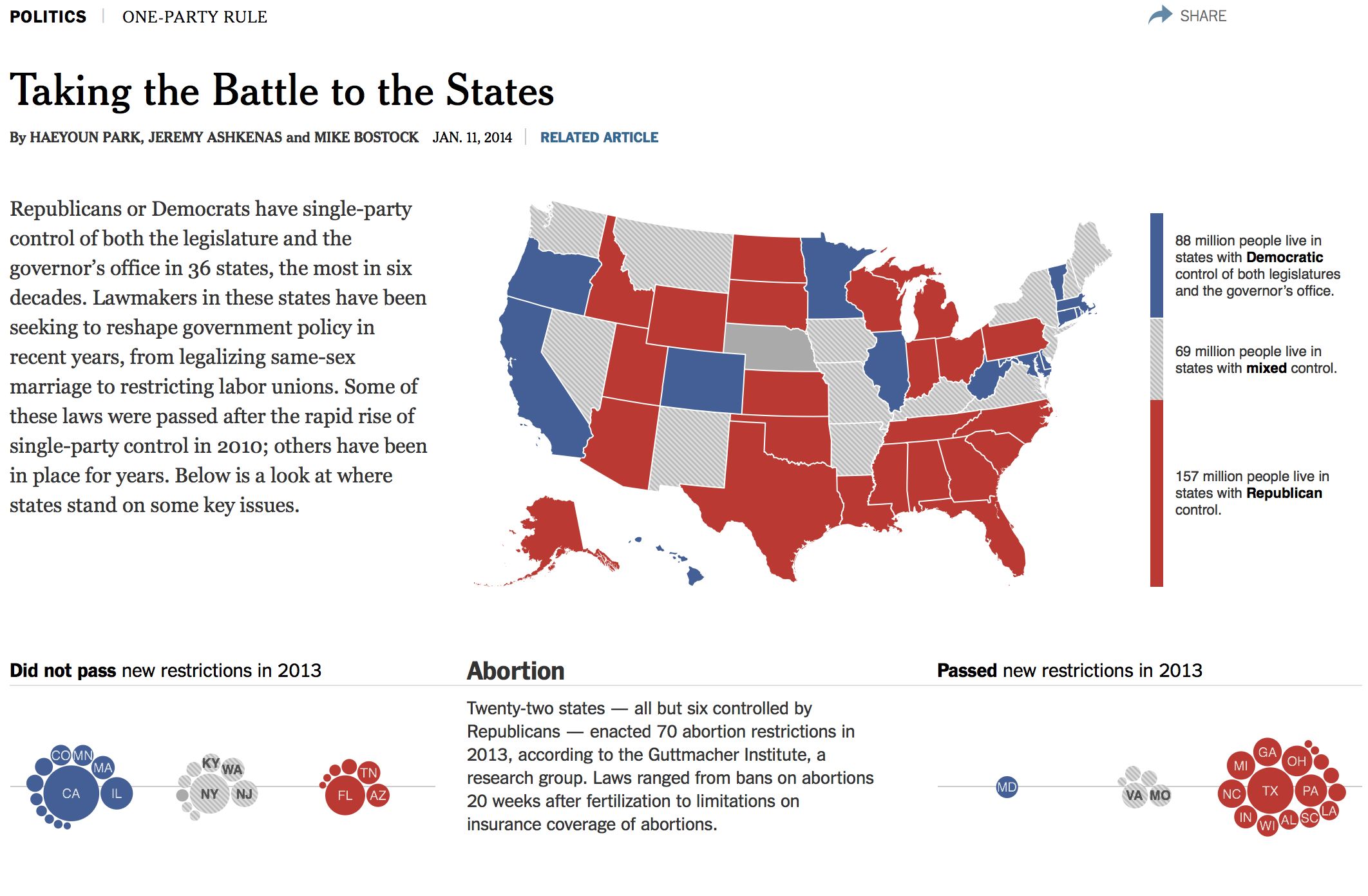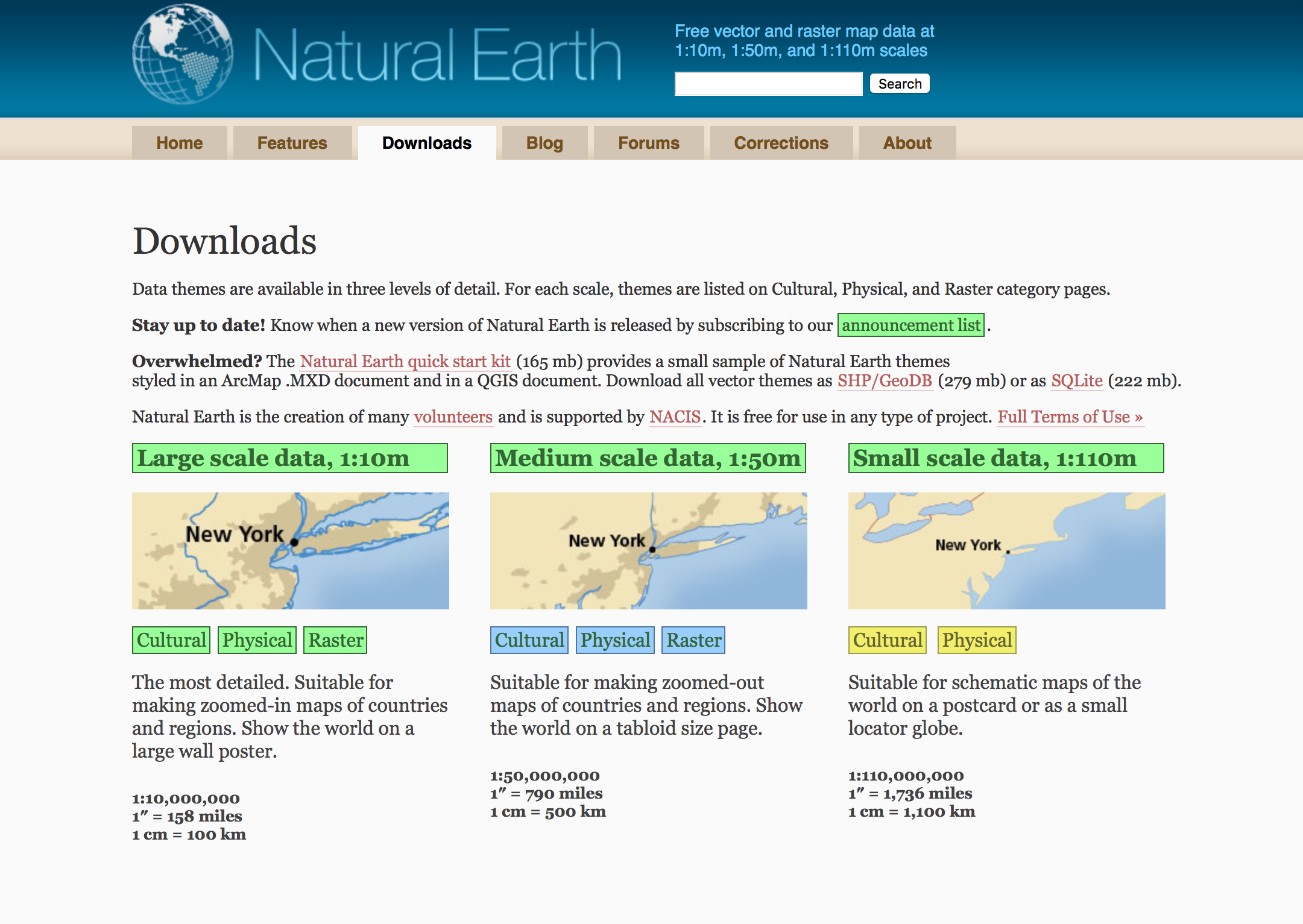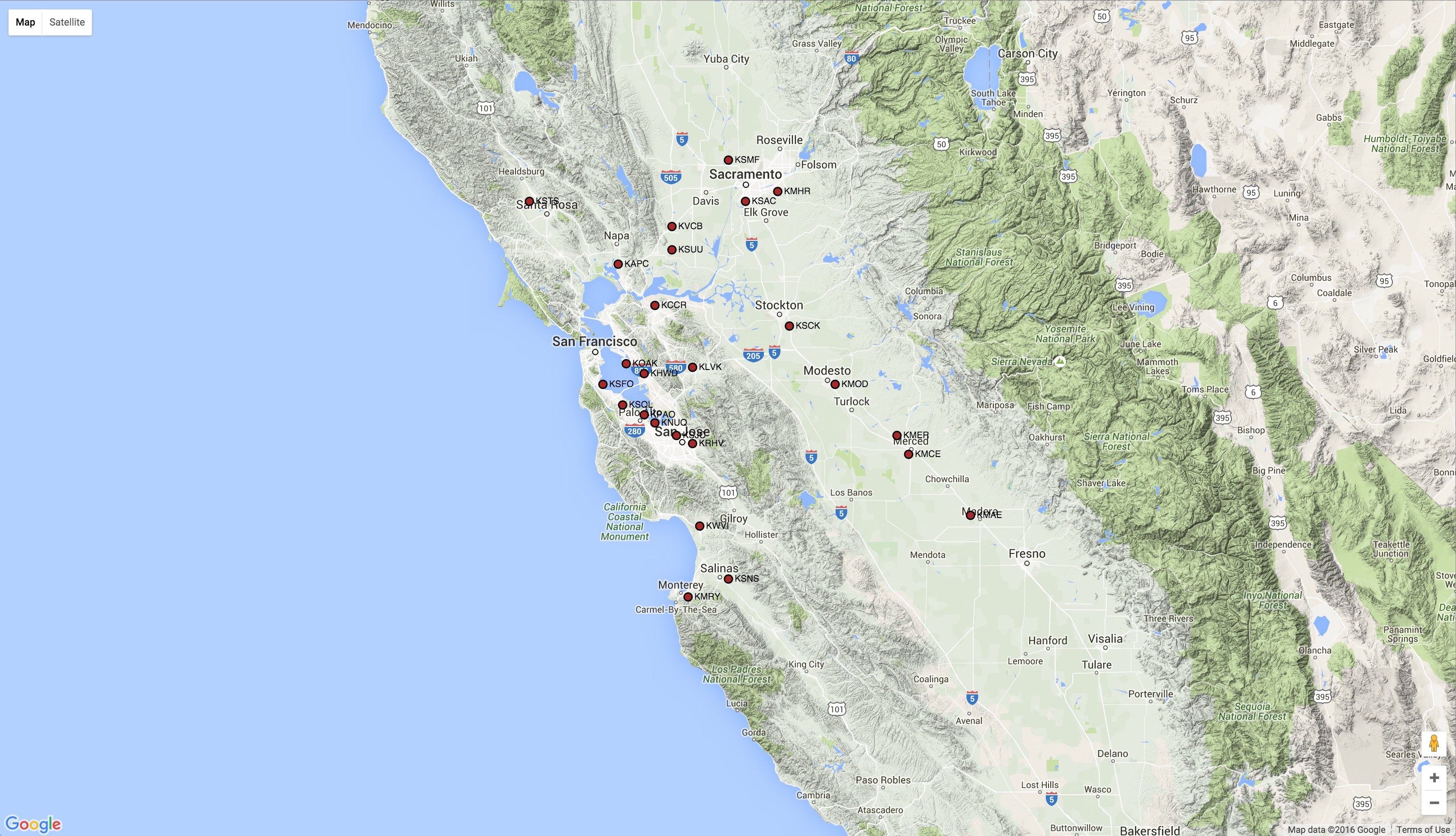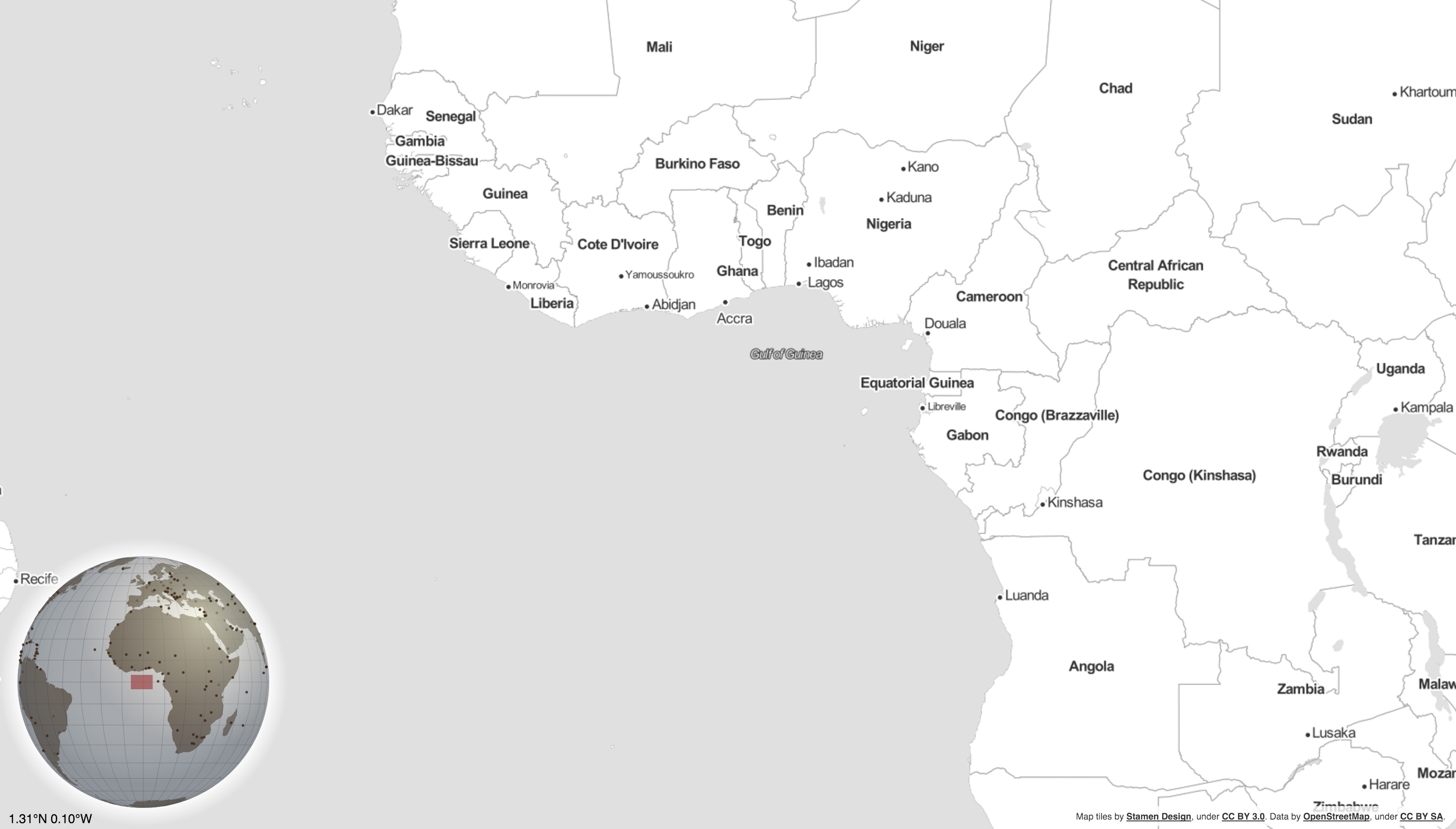How Can D3.js Fulfill All Your Cartographic Desires
Who am I?
Maps and visualizations
are my passion!
D3.js
- Data Driven Documents
- JavaScript library for manipulating documents based on data
- Bridges the gap between static display of data, and interactive and animated data visualizations
- It uses JavaScript, CSS, HTML and SVG to manipulate a DOM
- Its strength is in its data visualization ability
What is D3 used for?
To integrate and animate different connected charts

For Maps
Let's Make a Map
Data
1. Get the Data

2. Prepare the Data
3. Code
<!DOCTYPE html>
<html>
<head>
<meta charset="utf-8">
<title>D3 Hello World</title>
<script src="https://d3js.org/d3.v3.min.js"></script>
</head>
<body>
<script type="text/javascript">
d3.select("body").append("p").text("Hello World");
</script>
</body>
</html>
My first D3.js map
<!DOCTYPE html>
<html>
<head>
<meta charset="utf-8">
<title>D3 World Map</title>
<style>
/* CSS goes here. */
</style>
<script src="https://d3js.org/d3.v3.min.js"></script>
<script src="https://d3js.org/topojson.v1.min.js"></script>
</head>
<body>
<script type="text/javascript">
/* JavaScript goes here. */
</script>
</body>
</html>
<!DOCTYPE html>
<html>
<head>
<meta charset="utf-8">
<title>D3 World Map</title>
<style>
path {
stroke: white;
stroke-width: 0.5px;
fill: black;
}
</style>
<script src="https://d3js.org/d3.v3.min.js"></script>
<script src="https://d3js.org/topojson.v0.min.js"></script>
</head>
<body>
<script type="text/javascript">
var width = 950;
var height = 720;
var projection = d3.geo.mercator();
var svg = d3.select("body").append("svg")
.attr("width", width)
.attr("height", height);
var path = d3.geo.path()
.projection(projection);
var g = svg.append("g");
d3.json("world-110m2.json", function(error, topology) {
g.selectAll("path")
.data(topojson.object(topology, topology.objects.countries)
.geometries)
.enter()
.append("path")
.attr("d", path)
});
</script>
</body>
</html>
Projections
var projection = d3.geo.mercator();
var path = d3.geo.path()
.projection(projection);
- Geo Projections ... 12
- Extended Geographic Projections ... > 40
- Custom projections ... ∞
d3.geo.projectiond3.geo.projectionMutator
Let's Make a Second Map
index.html
<!DOCTYPE html>
<meta charset="utf-8">
<style>
path {
stroke: white;
stroke-width: 0.25px;
fill: grey;
}
</style>
<body>
<script src="https://d3js.org/d3.v3.min.js"></script>
<script>
var width = 960,
height = 600;
var projection = d3.geo.mercator()
.rotate([0, 0])
.center([15, 46])
.scale(4000)
.translate([width / 2, height / 2])
.precision(.1);
var path = d3.geo.path()
.projection(projection);
var svg = d3.select("body").append("svg")
.attr("width", width)
.attr("height", height);
var g = svg.append("g");
d3.json("zup.json", function (error, topology) {
g.selectAll("path")
.data(topology.features)
.enter()
.append("path")
.attr("d", path);
});
</script>
My second D3.js map with colors
<script>
d3.json("zup.json", function (error, topology) {
g.selectAll("path")
.data(topology.features)
.enter()
.append("path")
.attr("class", function(d) { return "zup" + d.properties.SIFRA; })
.attr("d", path);
});
</script>
<style>
path {
stroke: #000;
stroke-width: 0.5px;
}
.zup01, .zup08, .zup10, .zup12, .zup13, .zup19, .zup20 {
fill: #7fc97f;
}
.zup02, .zup03, .zup14, .zup15, .zup18 {
fill: #beaed4;
}
.zup04, .zup05, .zup07, .zup16 {
fill: #fdc086;
}
.zup06, .zup09, .zup11, .zup17, .zup21 {
fill: #ffff99;
}
</style>
My second D3.js map with colors
My second D3.js map with labels
<script>
d3.json("zup.json", function (error, topology) {
g.selectAll("path")
.data(topology.features)
.enter()
.append("path")
.attr("class", function(d) { return "zup" + d.properties.SIFRA; })
.attr("d", path);
g.selectAll("labels")
.data(topology.features)
.enter()
.append("text")
.attr("class", "labels")
.attr("transform", function(d) { return "translate(" + path.centroid(d) + ")"; })
.attr("dy", ".35em")
.text(function(d) { return d.properties.NAZIV; });
});
</script>
<style>
.labels {
fill: #666;
fill-opacity: .75;
font-size: 8px;
text-anchor: middle;
}
</style>
My second D3.js map with labels
My second D3.js map with tooltips
<script>
var tooltip = d3.select("body").append("div").attr("class", "tooltip");
d3.json("zup.json", function (error, topology) {
g.selectAll("path")
.data(topology.features)
.enter()
.append("path")
.attr("class", function(d) { return "zup zup" + d.properties.SIFRA; })
.on("mouseover", function(d) {
tooltip.html(d.properties.NAZIV);
})
.on("mouseout", function(d) {
tooltip.html("");
})
.attr("d", path);
});
</script>
<style>
.zup {
cursor: pointer;
}
.zup:hover {
fill: #386cb0;
}
.tooltip {
position: absolute;
top: 10px;
left: 10px;
}
</style>
My second D3.js map with tooltips
My final and interactive D3.js map
My final and interactive D3.js map
<!DOCTYPE html>
<meta charset="utf-8">
<style>
path {
stroke: #000;
stroke-width: 0.5px;
}
.background {
fill: none;
pointer-events: all;
}
.zup {
cursor: pointer;
}
.zup:hover {
fill: #386cb0;
}
.zup01, .zup08, .zup10, .zup12, .zup13, .zup19, .zup20 {
fill: #7fc97f;
}
.zup02, .zup03, .zup14, .zup15, .zup18 {
fill: #beaed4;
}
.zup04, .zup05, .zup07, .zup16 {
fill: #fdc086;
}
.zup06, .zup09, .zup11, .zup17, .zup21 {
fill: #ffff99;
}
.tooltip {
position: absolute;
top: 10px;
left: 10px;
background: #fff;
padding: 5px;
}
</style>
<body>
<script src="https://d3js.org/d3.v3.min.js"></script>
<script>
var width = 960,
height = 600,
active = d3.select(null);
var projection = d3.geo.mercator()
.rotate([0, 0])
.center([15, 46])
.scale(4000)
.translate([width / 2.5, height / 7])
.precision(.1);
var zoom = d3.behavior.zoom()
.translate([0, 0])
.scale(1)
.scaleExtent([1, 8])
.on("zoom", zoomed);
var path = d3.geo.path()
.projection(projection);
var svg = d3.select("body").append("svg")
.attr("width", width)
.attr("height", height)
.on('click', stopevents, true);
var g = svg.append("g");
g.append("rect")
.attr("class", "background")
.attr("width", width)
.attr("height", height)
.on("click", resetZoom);
svg
.call(zoom)
.call(zoom.event);
var tooltip = d3.select("body").append("div").attr("class", "tooltip");
d3.json("zup.json", function (error, topology) {
g.selectAll("path")
.data(topology.features)
.enter()
.append("path")
.attr("class", function(d) { return "zup zup" + d.properties.SIFRA; })
.on('click', zoomToClick)
.on("mouseover", function(d) {
tooltip.html(d.properties.NAZIV);
})
.on("mouseout", function(d) {
tooltip.html("");
})
.attr("d", path);
});
function zoomed() {
g.attr('transform', 'translate(' + d3.event.translate + ')scale(' + d3.event.scale + ')');
}
function zoomToClick(d) {
if (active.node() === this) return resetZoom();
active.classed("active", false);
active = d3.select(this).classed("active", true);
var bounds = path.bounds(d),
dx = bounds[1][0] - bounds[0][0],
dy = bounds[1][1] - bounds[0][1],
x = (bounds[0][0] + bounds[1][0]) / 2,
y = (bounds[0][1] + bounds[1][1]) / 2,
scale = .9 / Math.max(dx / width, dy / height),
translate = [width / 2 - scale * x, height / 2 - scale * y];
svg.transition()
.duration(750)
.call(zoom.translate(translate).scale(scale).event);
}
function resetZoom() {
active.classed("active", false);
active = d3.select(null);
svg.transition()
.duration(750)
.call(zoom.translate([0, 0]).scale(1).event);
}
function stopevents() {
if (d3.event.defaultPrevented) { d3.event.stopPropagation(); }
}
</script>
More D3.js Map Examples
In the end ...
Vector Manipulation on the Fly

